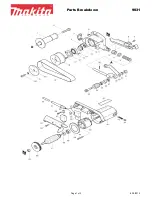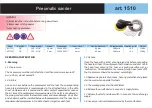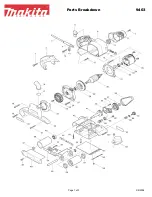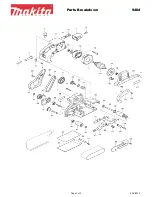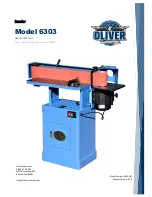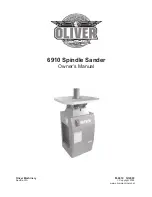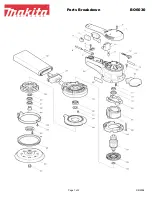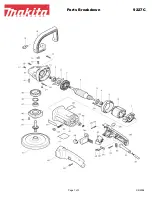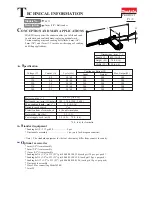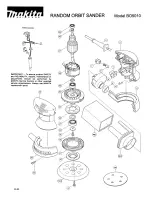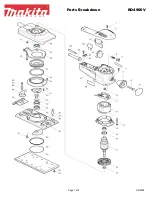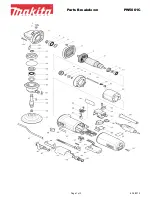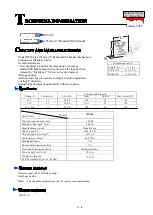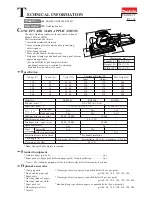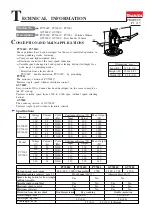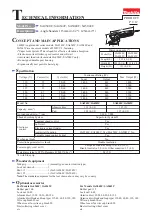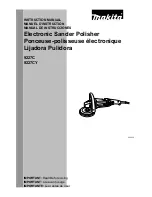
11 Sp
Manual de Instrucciones
Guía de solución de poblemas
Problema
Causa(s) posible
Acción correctiva
La herramienta
funciona demasiado
lenta o no funciona.
Sale humedad por la
herramienta
La lijadora se detiene
cuando se aplica a la
superficie de trabajo.
1. Hay arena o goma en la
herramienta
2. No hay aceite en la
herramienta
3. Baja presión de aire
4. Fugas en la manguera
de aire
5. Baja la presión
6. Posición muy baja del
regulador
1. Hay agua en el tanque
2. Hay agua en las
líneas/mangueras de aire
El seguro del eje se
encuentra en la posición
de cerrado.
1. Limpie la herramienta con aceite para herramientas hidráulicas
Campbell Hausfeld, solvente de goma o una mezcla de mitad de
aceite para motor SAE 10 y mitad de queroseno. Si no utiliza
aceite Campbell Hausfeld, lubrique la herramienta después de
limpiarla.
2. Lubrique la herramienta siguiendo las instrucciones sobre
lubricación que aparecen en este manual.
3a. Ajuste el regulador de la herramienta al máximo permitido (Si
es aplicable).
3b. Ajuste el regulador del compresor al máximo permitido por la
herramienta mientras ésta funciona libremente.
4. Apriete y selle los accesorios de la manguera si encuentra fugas.
5a. Asegúrese de que el tamaño de la manguera sea el apropiado.
Las mangueras largas o las herramientas que utilizan grandes
volúmenes de aire pueden requerir una manguera con un D.I.
de 1/2 pulgada o superior, según el tamaño total de la
manguera.
5b. No utilice varias mangueras conectadas con accesorios de
conexión rápida. Esto ocasiona la caída adicional de presión y
reduce la potencia de la herramienta. Conecte directamente las
mangueras.
6. Ajuste el regulador hasta que la herramienta alcance la
velocidad máxima.
1. Vacíe el tanque. (Vea el manual del compresor de aire).
Lubrique la herramienta y hágala funcionar hasta que no haya
agua. Vuelva a lubricar la herramienta y hágala funcionar por
1 a 2 segundos.
2a. Instale un separador/filtro de agua (PA2121). NOTA: Los
separadores sólo trabajan adecuadamente cuando el aire que
pasa a través del separador está frío. Ubique el separador/
filtro lo más lejos posible del compresor.
2b. Instale un secador de aire.
2c. En el momento que ingrese agua a la herramienta, ésta se debe
aceitar inmediatamente.
Quite el seguro del eje (Ver figura 1).
Funcionamiento
(Continuación)
Utilizar
una
manguera de conexión flexible evita
que se accione el gatillo de la
herramienta en forma accidental,
cuando se conecta el aire presurizado
al sistema.
Asimismo, la vibración de la
herramienta desgasta los acopladores
rápidos en forma prematura.
Utilizar accesorios o mangueras de aire
que son muy pequeños puede crear
una caída de presión o reducir la
potencia de la herramienta. Se
recomienda el uso de accesorios de
9,5mm (3/8”) con roscas NPT de 6,4mm
(1/4”). La mayoría de compresores
vienen con una manguera corta, con
un D.I. de 6,4mm (1/4”). Para obtener
!
ADVERTENCIA
mayores beneficios y un desempeño
adecuado, utilice una manguera con
D.I. de 9,5mm (3/8”). Las mangueras de
más de 15m (15 pies) deben tener un
D.I. de 12,7mm (1/2”).
Nunca
cargue la
herramienta sujetándola de la
manguera ni jale de ésta para moverla
o mover el compresor. Man-tenga la
manguera lejos del calor, aceite y
bordes contundentes. Reem-place la
manguera si está averiada, débil o
desgastada.
Mantenimiento
ALMACENAMIENTO
Debe lubricar la herramienta
neumática antes de almacenarla. Siga
las instrucciones para lubricar el pistón
neumático excepto el paso 4. Déjela
funcionar de 2 a 3 segundos sólamente
!
ADVERTENCIA
en vez de 7 a 10 segundos ya que la
herramienta necesita más aceite para
almacenarla.
Información sobre
Repuestos
Para mayor información sobre donde
puede ordenar repuestos,
comuníquese con el concesionario de
Campbell Hausfeld más cercano a su
domicilio. Sírvase suministrarnos la
siguiente información:
• Número del Modelo
• Código grabado en la herramienta
• Número y descripción del repuesto
Puede escribirnos a:
The Campbell Group
Attn: Parts Department
100 Production Drive
Harrison, Ohio 45030
Operation
(Cont.)
This air tool
requires lubrication
before the initial use and before and
after each additional use.
Air tools require lubrication
throughout the life of the tool. Follow
the outlined procedures carefully.
Campbell Hausfeld air tool oil
(ST127000AV) is recommended because
this oil cleans, lubricates and inhibits
rust all in one step.
AIR MOTOR LUBRICATION
The air motor must be lubricated
daily
. An air motor cannot be oiled
too often.
Disconnect the
air tool from the
air supply before lubricating.
1. Disconnect the tool from the air
supply.
2. Turn the air tool upside down.
3. Simultaneously (at the same time),
pull the trigger and pour a
teaspoon of Campbell Hausfeld oil
in the air inlet.
After an air tool
has been lubri-
cated, oil will discharge through the
exhaust port during the first few
seconds of operation. Thus, the ex-
haust port must be covered with a
towel before applying air pressure.
Failure to cover the exhaust port can
result in serious injury.
4. Release the trigger and connect the
air tool to the air supply. Cover the
exhaust port with a towel then run
the air tool for 7 to 10 seconds. Oil
will discharge from the exhaust
port when air pressure is applied.
Continue to run the sander until no
oil is discharged. Wipe all residual
oil from the tool before use.
SPEED ADJUSTMENT
This sander is equipped with a
regulator for speed adjustment (See
Replacement Parts List for
Specifications).
ATTACHING SANDING PAD/DUAL
ACTION SANDERS
Adhesive backed discs are
recommended. To apply the sandpa-
per, align outside edge and press self
adhesive paper onto the pad. Change
sandpaper as needed.
Disconnect the air
tool from the air
!
WARNING
!
WARNING
!
WARNING
!
CAUTION
2
Operating Instructions
supply before attaching the sanding
pad. Do not operate the sander if
sanding pad is not securely tightened.
Always replace a worn or damaged
pad. Serious injury could occur.
1. Lock the drive spindle in place
before attaching the sanding pad.
Rotate the spindle lock until the
spindle lock engages with the drive
spindle and hand-tighten the
sanding pad in a clockwise direc-
tion (See Figure 1).
2. Unlock the spindle before applying
air pressure.
NOTE:
The spindle lock is for attaching
and removing the sanding pad only!
Do not operate the tool with the
spindle locked or the sander will stall
when pressure is applied to the pad.
ATTACHING SANDING DISCS/HIGH
SPEED SANDERS
3” or 6” resin discs with non-adhesive
backs are recommended. The discs
should have 7/8” diameter cutout
centers for proper attachment. For
best support When using discs larger
than 3", use all the backup pads of
equal size or smaller than the resin disc
itself (See Fig. 2). To install the resin
disc, follow the outlined procedures.
Disconnect the air
tool from the air
supply before attaching the sanding
disc. Do not operate the sander if
!
WARNING
sanding disc is not securely tightened
or serious injury could occur.
1. Assemble the backup pads as
shown in Figure 2. Make sure the
recessed center of the pads face
the sander.
2. Place the resin disc in front of the
appropriate size pad and push the
adapter lock down through the
center of the pad and discs.
3. Hand tighten the adapter
lockdown, then insert the holding
tool into the hole shown in Figure
2. Insert a large screwdriver into
the slotted hole on the adapter
lock down and securely tighten.
SANDING/DUAL ACTION SANDERS
Begin sanding with an abrasive grit
coarse enough to remove the high
spots and any excessive roughness.
Follow with a second sandpaper using
a grit one to two ranges finer.
Continue with successively finer grits
until the desired finish is obtained. Do
not change from a coarse grit to a very
fine grit in one step. In doing so, it is
difficult to remove swirl marks that
might have been made by the coarse
grit abrasive. Always use the finest grit
practical for the sanding operation.
GRINDING/HIGH SPEED SANDERS
The coarse resin disc is used for
removing or smoothing over welds or
blending uneven metal surfaces. The
most common grit is 36 (Campbell
Hausfeld MP3264 discs).
Worn or damaged
sanding discs may
break apart causing serious injury.
Always replace discs as needed.
AIR HOSE
Refer to IN170102 Air Hose Hookup
Installation sheet for hookup
specifications.
NOTE:
It is not recommended to install
a quick coupler between the sander
and the leader (whip) hose.
Use of a whip hose
prevents
accidental triggering of the tool when
pressurized air is connected to the
system.
In addition, the tool’s vibration wears
out quick couplers prematurely.
!
WARNING
!
WARNING
Spindle Lock
Pad
Assembly
Position
Operating
Position
Drive
Spindle
Adapter
Lock
Down
5-1/2”
Backup Pad
4-1/2” Backup Pad
3” Backup Pad
Insert Holding
Tool Here
Figure 1
Figure 2
www.chpower.com













